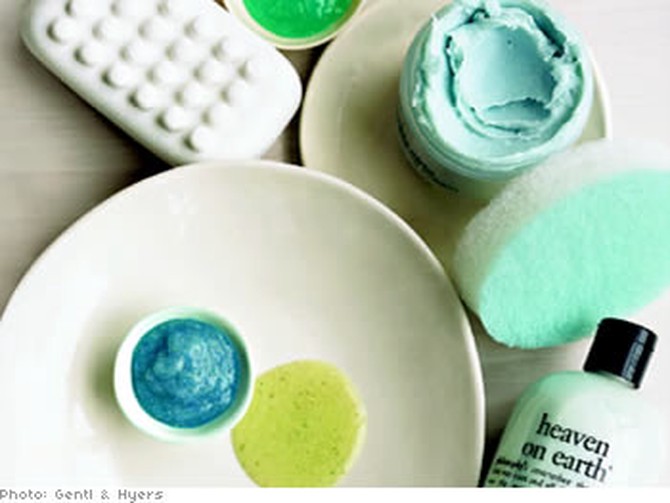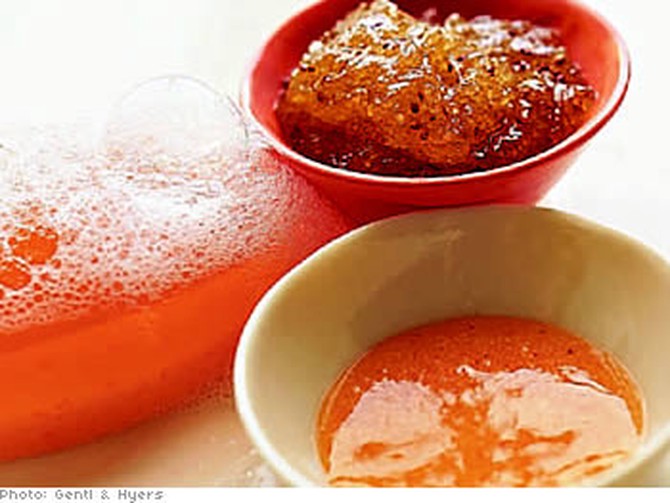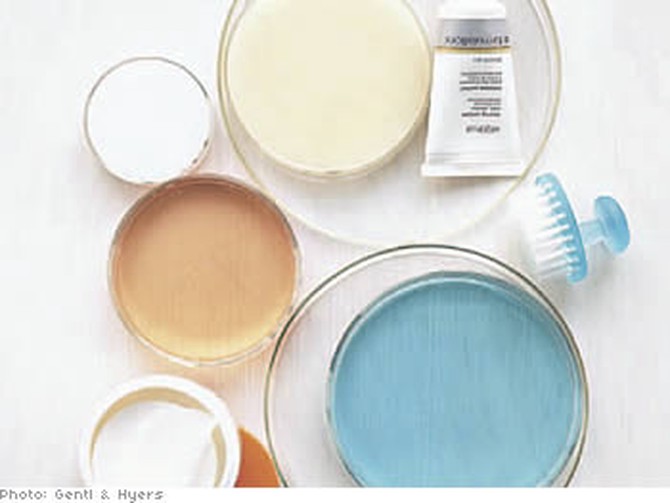Skin Magic

Loofahs or granular scrubs
Massaging with light pressure removes dead cells. For the face, try a soft washcloth or a Buf-Puf. As for granular scrubs, the gentler the better. Soft synthetic beads should be plentiful in the formula (look for "polyethylene" near the top of the ingredients list). For the body, coarser scrubs and loofahs are fine as long as skin is not dry, irritated, or cracked. Exfoliating manually is safe once a day or a couple of times a week, but scrub only for about a minute, apply light pressure, and use a good moisturizer afterward. Cost: $4 to $60.
Chemical exfoliants
These acids, which come in varying strengths dissolve the glue-like bonds that stick dead cells to the skin's surface. Using an acid at night in conjunction with a manual exfoliator in the morning sweeps away the loosened cells faster than either method alone. Acids exfoliate deeper than scrubs (although still superficially), and because the application is uniform (there's no scrubbing involved), the results are more predictable.
If your skin is oily, use a BHA, because the hydrating effects of AHAs can make oily skin look shiny. Start with a low-strength formula; if your skin tolerates it well, after two weeks you can begin alternating every other day with the next strongest formula. Cost: $4 to $50.
Massaging with light pressure removes dead cells. For the face, try a soft washcloth or a Buf-Puf. As for granular scrubs, the gentler the better. Soft synthetic beads should be plentiful in the formula (look for "polyethylene" near the top of the ingredients list). For the body, coarser scrubs and loofahs are fine as long as skin is not dry, irritated, or cracked. Exfoliating manually is safe once a day or a couple of times a week, but scrub only for about a minute, apply light pressure, and use a good moisturizer afterward. Cost: $4 to $60.
Chemical exfoliants
These acids, which come in varying strengths dissolve the glue-like bonds that stick dead cells to the skin's surface. Using an acid at night in conjunction with a manual exfoliator in the morning sweeps away the loosened cells faster than either method alone. Acids exfoliate deeper than scrubs (although still superficially), and because the application is uniform (there's no scrubbing involved), the results are more predictable.
If your skin is oily, use a BHA, because the hydrating effects of AHAs can make oily skin look shiny. Start with a low-strength formula; if your skin tolerates it well, after two weeks you can begin alternating every other day with the next strongest formula. Cost: $4 to $50.

At-home peels
These are "retexturizing" masks or cloth pads containing AHAs and/or BHAs in concentrations of 8 percent to 15 percent glycolic acid, 5 percent to 12 percent lactic acid, and 2 percent salicylic acid. Peels exfoliate in the same way as AHA and BHA lotions, but because they're more potent, they yield slightly more dramatic results. If skin is very rough or dull, an at-home peel can work better and quicker than other nonprescription methods. With stronger formulas, there's greater potential for irritation. If you apply too much product, use a peel too often, or use it in conjunction with other strong exfoliating agents, skin could peel too deeply, leaving you red for days. Light tingling or burning is common (it shouldn't last longer than a few minutes) as is temporary redness (an hour or so). Cost: $4 to $124.
Professional peels
Three levels of peels—light, medium, and deep—that consist of one acid or a combination of acids in high concentrations. Typically performed on face, chest, or hands. Medium and deep peels help correct the effects of long-term sun damage: wrinkles, thinning skin, hyperpigmentation, and precancerous cells. In all professional peels, the acids "burn" the skin to trigger a repair response. Light peels affect only the epidermis, and it's safe to get one every six weeks. The results from just one medium or deep peel can last from months to years. If improving skin texture is your only goal, medium and deep peels aren't for you. Skin is red for up to three weeks, and usually a surface crust forms. This falls off after a week, and the redness turns to pink, which can last one to three months. Deep peels may require local anesthesia or pain medication. Cost: $150 to $250 for light peels; $1,200 to $3,500 for medium and deep peels.
These are "retexturizing" masks or cloth pads containing AHAs and/or BHAs in concentrations of 8 percent to 15 percent glycolic acid, 5 percent to 12 percent lactic acid, and 2 percent salicylic acid. Peels exfoliate in the same way as AHA and BHA lotions, but because they're more potent, they yield slightly more dramatic results. If skin is very rough or dull, an at-home peel can work better and quicker than other nonprescription methods. With stronger formulas, there's greater potential for irritation. If you apply too much product, use a peel too often, or use it in conjunction with other strong exfoliating agents, skin could peel too deeply, leaving you red for days. Light tingling or burning is common (it shouldn't last longer than a few minutes) as is temporary redness (an hour or so). Cost: $4 to $124.
Professional peels
Three levels of peels—light, medium, and deep—that consist of one acid or a combination of acids in high concentrations. Typically performed on face, chest, or hands. Medium and deep peels help correct the effects of long-term sun damage: wrinkles, thinning skin, hyperpigmentation, and precancerous cells. In all professional peels, the acids "burn" the skin to trigger a repair response. Light peels affect only the epidermis, and it's safe to get one every six weeks. The results from just one medium or deep peel can last from months to years. If improving skin texture is your only goal, medium and deep peels aren't for you. Skin is red for up to three weeks, and usually a surface crust forms. This falls off after a week, and the redness turns to pink, which can last one to three months. Deep peels may require local anesthesia or pain medication. Cost: $150 to $250 for light peels; $1,200 to $3,500 for medium and deep peels.

At-home microdermabrasion
Either a paste or a scrub containing aluminum oxide crystals, sometimes used in conjunction with a battery-operated handpiece that rotates or vibrates a sponge or soft brush. The friction from the crystals and the sponge or brush give you a deeper (although still superficial) exfoliation than scrubs.The coarseness of the pastes and scrubs plus added friction from the attachment equals increased potential for temporarily damaging the skin (leaving it red and irritated and possibly scarring darker skin tones). Never use these products more than once a week. Cost: $30 to $130.
Professional microdermabrasion/dermabrasion
For microdermabrasion, aluminum oxide crystals or purified salt shoots out from a wand that immediately vacuums it up. For dermabrasion, a rotating rough wire brush or burr is used. During microdermabrasion, the materials sandblast away the top layer of the skin. Texture is smoothed and the mild pinkness can look like a glow. Dermatologists often use the procedure to maintain the results of laser resurfacing or to increase the penetration of prescription skin lighteners. Some evidence shows it may help reduce scars, although deeper resurfacing (dermabrasion) and other treatments (laser procedures) are usually needed. Dermabrasion is used mostly for smoothing scars and wrinkles. Microdermabrasion can irritate sensitive skin; avoid it if you have rosacea or a tendency toward redness.The vacuuming action in frequent treatments can lead to broken blood vessels, though if your skin can tolerate it, monthly treatments are considered safe. Cost: On average, $200 for microdermabrasion; $1,500 for dermabrasion.
Either a paste or a scrub containing aluminum oxide crystals, sometimes used in conjunction with a battery-operated handpiece that rotates or vibrates a sponge or soft brush. The friction from the crystals and the sponge or brush give you a deeper (although still superficial) exfoliation than scrubs.The coarseness of the pastes and scrubs plus added friction from the attachment equals increased potential for temporarily damaging the skin (leaving it red and irritated and possibly scarring darker skin tones). Never use these products more than once a week. Cost: $30 to $130.
Professional microdermabrasion/dermabrasion
For microdermabrasion, aluminum oxide crystals or purified salt shoots out from a wand that immediately vacuums it up. For dermabrasion, a rotating rough wire brush or burr is used. During microdermabrasion, the materials sandblast away the top layer of the skin. Texture is smoothed and the mild pinkness can look like a glow. Dermatologists often use the procedure to maintain the results of laser resurfacing or to increase the penetration of prescription skin lighteners. Some evidence shows it may help reduce scars, although deeper resurfacing (dermabrasion) and other treatments (laser procedures) are usually needed. Dermabrasion is used mostly for smoothing scars and wrinkles. Microdermabrasion can irritate sensitive skin; avoid it if you have rosacea or a tendency toward redness.The vacuuming action in frequent treatments can lead to broken blood vessels, though if your skin can tolerate it, monthly treatments are considered safe. Cost: On average, $200 for microdermabrasion; $1,500 for dermabrasion.
From the April 2004 issue of O, The Oprah Magazine

